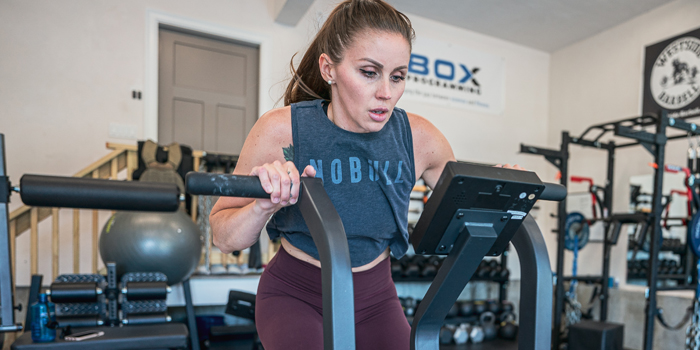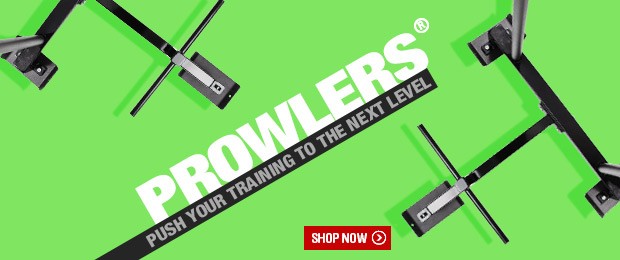
Conjugate and Conditioning: Going Beyond The Sled
One tenet of the conjugate method and improving maximal strength is its connection to strength-endurance, albeit both special strengths could not be further from each other (most would not associate the two in the same light.) Using measures like sled pulls, we can effectively improve aerobic capacity/oxidative qualities of the musculature of hips, hamstrings, and calves and bridge the gap between max effort and dynamic effort training sessions. Think of the sled as an intermediary to improve strength qualities with the same cost to the nervous and muscular system because there is zero axial loading.
RECENT: 6 Foundational Movement Pattern Variations
Moreover, the sled will also improve the oxidative quality of fast-twitch fibers. We know that Type 2 fibers have aerobic ability and anaerobic abilities, strengthening the connection between maximal and submaximal strength development and strength-endurance. We know the sled is an incredibly versatile tool that can upgrade your training for less than $120 bucks. Still, the sled is simply one tool. Conjugate training is known for using as many tools as necessary to improve upon limitations, and improving your conditioning should not be any different.
If you’re asking these questions, this article is for you:
- What about other conditioning methods? What could those look like in conjunction with a classic conjugate split?
- What do you do on the days between max effort (ME) and dynamic effort (DE) sessions?
- What do I do on a fifth day?
Before you read any further, I’m going to ask you to be open-minded. Some of the concepts I’m going to introduce to you are going outside of what you think would be prudent to gain maximal strength.
Once you hear the actual science behind these methods and see how they’re delivered, it should make more sense. Also, these methods could reveal serious areas of weakness for you. Any conjugate trainee is not averse to attacking weaknesses knowing that improving upon limitations lends itself to the overall goal of increasing their lifts. Still, these weaknesses will likely make you even more uncomfortable as the setting will be different than you’re used to.
This article will highlight three methods that you can use in conjunction with your conjugate split. I’ll show you how to program them, where to place, and give you all the science behind their “why.”
For the record, these methods can be regressed and progressed in more than a few ways, so they’ll have the power to span across multiple abilities—a huge advantage if you’re working with clients online. Also, while I mentioned there is a whole world outside of the sled, the sled can still be used with some of these methods. The way it’s programmed in terms of load, duration, and overall intent will lend itself to the day's objective. This will make more sense after you read the entire article. Furthermore, while there is a long list of methods that go far beyond what’s mentioned in this article, these three methods develop the aerobic system—which for many, is an area of weakness and thus low-hanging fruit.
The Methods
High-Intensity Intervals
High-Intensity Intervals aims to use a variety of sustainable exercises with incomplete bouts of rest after each round. The intent is to stimulate higher oxygen utilization and improve the aerobic abilities of fast-twitch fibers. Notice, I used the word “sustainable,” so when we think about movements that can be sustained for longer durations, we are not thinking about using locally demanding movements like a push-up or pull-up that have high rates of peripheral fatigue. Most trainees will be limited by local muscle-endurance, not their overall level of aerobic conditioning. When we select movements, they need to be movements you could sustain for 30-60s without stopping.
Guidelines:
- Low resistance movements that can be sustained for the entire interval without stopping
- 15-20 minutes in total duration
- Incomplete rest intervals
- 1-2 sessions per week
Sample Programming:
5 Rounds of:
- Air Bike for Calories x 60s
- Russian Kettlebell Swings x 60s
- Rowing Machine for Calories x 60s
- Box Step-ups (unweighted) x 60s
- Rest x 60s
Of course, you can get creative using different variations, but the key takeaway is that you should have sustained output for all sets, meaning round one should not look much different from the last round. This style of workout will leave you feeling relatively fresh thereafter and with a good sweat! Again, choose movements that are sustainable for you and allow you to work for a prescribed duration without stopping—this shouldn’t be a brutally hard conditioning piece.
Cardiac Output Method
With this method, you may stop reading when you hear the words “low-intensity” or “steady-state,” but as I said before, be open-minded because this is the premier method for improving the aerobic system. The reasoning is simple: without an efficient aerobic system, your ability to recover between sessions and between working sets will not be what it could be. Moreover, improving your aerobic system can literally extend how long you live. The connection between aerobic fitness and lifespan is pretty well established, with numerous studies to back it up like this one here. In fact, this method was the single most beneficial method for my own training and took my conditioning to a level I didn’t know existed.
The hardest part for most is that it’s too easy (yes, it’s easy to do), and it can be somewhat boring, but how we customize these sessions while still keeping the intent intact is key. First off, let’s discuss what cardiac output is. Cardiac output is the amount of blood the heart pumps through the circulatory system in one minute. In layman’s terms, it’s a product of heart rate and stroke volume, so this training style influences the heart’s ability to pump blood to the extremities. More importantly, it can increase the cavity volume known as ‘eccentric hypertrophy,’ particularly of the heart's left ventricle.
I know what you’re thinking, "Can’t I arrive at these same adaptations by simply lifting weights!?" No, you cannot! The reason being, eccentric hypertrophy (stretching) of cardiac tissue is a result of low-intensity conditioning done for longer durations, and the heart-rate needs to be in a specific range for this to occur. On the other hand, weight-training results in more of ‘concentric hypertrophy’ of cardiac tissue, which is a thickening of the walls—two very different things. So, improving cardiac output is done in very specific settings with very specific measures. And no, this type of work will NOT take away from your strength gains when done correctly. Let’s dive right into programming.
Guidelines:
- Select 2-3 pieces of cardio equipment
- Perform 10-15 minutes of steady-state ‘conversational style’ work on each
- Perform 1-2 sessions a week as their own training session
- Heart-rate of 130-150 BPM or 60-70% of MHR
Sample Programming:
- 10 Minutes of Air Bike
- 10 Minutes of Rowing Machine
- 10 Minutes of Light Sledpull Powerwalk (a weight you can walk continuously with without stopping)
For most people, 30 minutes is more than enough, but if you’re already more aerobically inclined, you can go as long as 60 minutes. On the other hand, if you have zero aerobic fitness, start with 20 minutes and progress to 30 minutes over the course of eight weeks. Remember, this work is intended to be ‘easy,’ so if you can’t carry on a conversation while doing it, you’re going too hard!
Sled work and Loaded Carry Combo
Clearly, this method will not come as a shocker to many, but there are more than a few caveats with programming this method. In terms of when you do it, do you perform it in a separate session or on a ME or DE lower day? In this case, the sets' duration will be longer, and loading will be lower, making this a better fit for its own conditioning session. On the other hand, these two modalities could be used for anaerobic work using heavier loads for more sets/shorter durations, but that’s another article. Sled Work and Loaded Carry Combo is a great way to train aerobic abilities of fast-twitch fibers and maintain posture when heart-rate is elevated and when fatigue begins to set in. Here’s what you need to know:
Guidelines:
- 8-12 sets x 60s-90s & 90s rest between sets
- Or for a set distance of 400-800 meters for time
- 1 session per week
Sample Programming:
- 1a. Sledpush Sprint: 8 x 60 yards. No rest.
- 1b. Crossbody Farmer Carry: 8 x 60 yards. Rest 90s - 2:00
Or
For time:
- 400 Meter Sled Pull Farmer Carry
- 25% BW on Sled (includes sled weight) + 50% of BW (total in each hand)
- Goal is to stop as little as possible
- Shoot for sub 15:00
How To Use in Conjugate Programming
Option #1:
- Monday: ME Lower
- Tuesday: High-Intensity Intervals
- Wednesday: ME Upper
- Thursday: Cardiac Output Method
- Friday: DE Lower
- Saturday: DE Upper
- Sunday: OFF
Option #2
- Monday: ME Lower
- Tuesday: Sledwork & Loaded Carry Combo
- Wednesday: ME Upper
- Thursday: Cardiac Output Method
- Friday: DE Lower
- Saturday: DE Upper
- Sunday: Cardiac Output Method
These three ways to take your conditioning to the next level will incur gains in maximal strength and muscle hypertrophy. Skipping conditioning work will not lead to maximum sustainability or your all-time best. For many, simply adding something like the Cardio Output Method can completely change your recoverability and work-capacity with things like dynamic effort work!
Header image courtesy of RX Photography











thanks